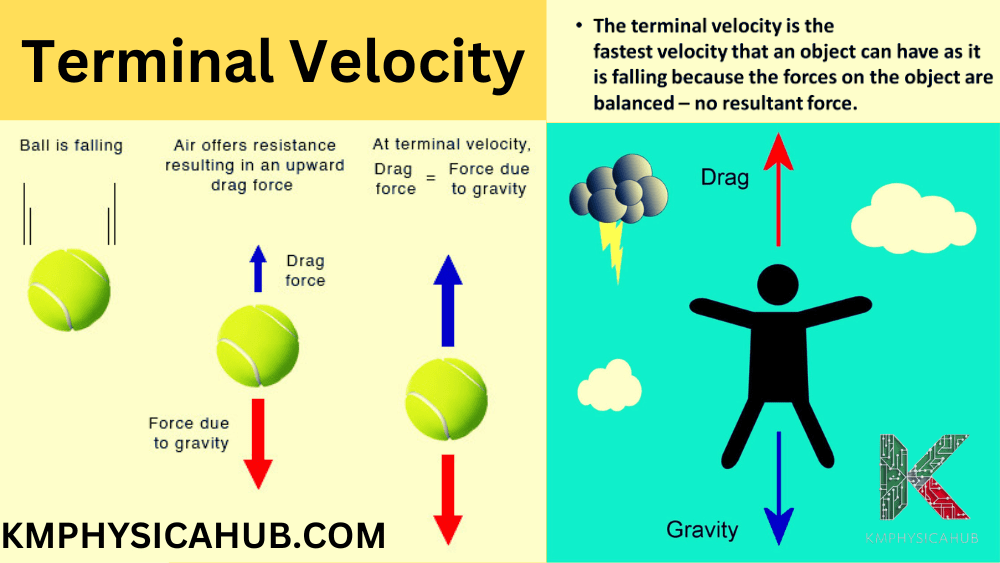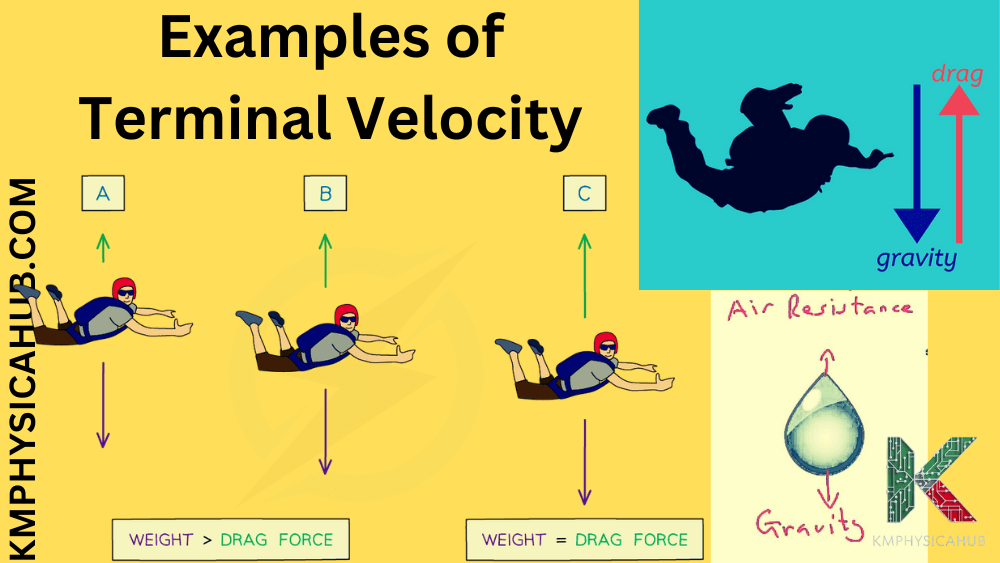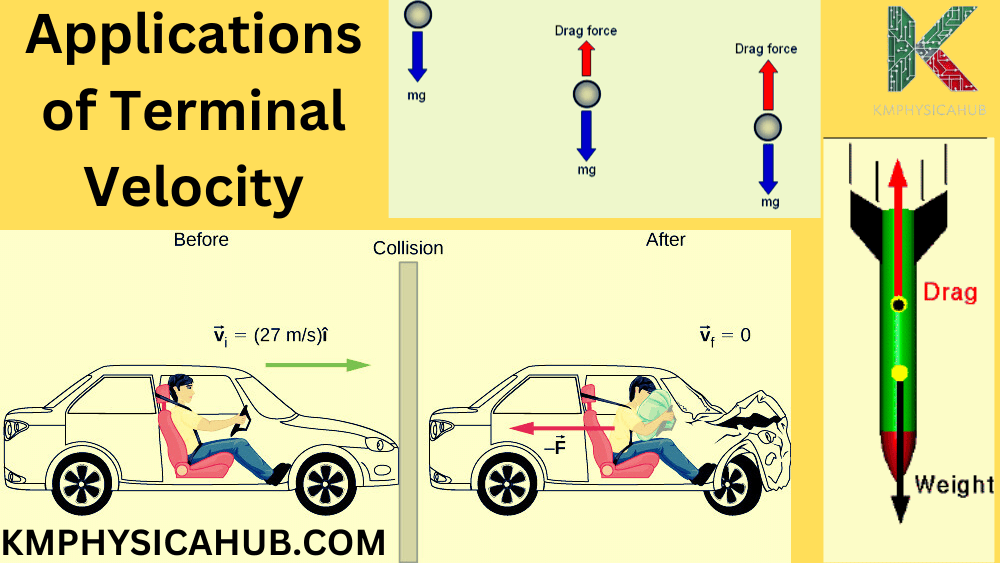Real-World Examples and Applications of Terminal Velocity
What is Terminal Velocity?
Terminal velocity is the velocity attained by an individual or an object falling freely when the downward force of gravity equals the upward force of the resistance in the air. Try to visualize a person who is jumping from a plane and is free-falling towards the land surface. At first he moves fast due to the force of gravity. However, as his speed goes up, he has to overcome more force of the air pushing against it. At some point, these forces balance, and the skydiver ceases to gain further speed, attaining a highest speed known as the terminal velocity.
Historical Context of Terminal Velocity:
Early observations of falling objects hinted at the existence of a limiting speed. In early 17th century Galileo Galilei made experiments of falling objects and realized that the heavier bodies do not descend faster than the lighter ones. This led to the development of the concept of air resistance, how it affects falling bodies and their velocities. But the concept of terminal velocity in physics came later when there were pretty developments in the field of fluid dynamics and aerodynamics.
The Physics behind Terminal Velocity
Gravity’s Pull:
There is no force acting on an object initially if it is at rest until gravity comes in to pull the object downwards when it is dropped. This force makes the object go faster and thus call for an increase in speed which marks the acceleration. The acceleration due to gravity does not change much with distance from the center of the Earth and is typically about 9 m/s². This means that the speed of the objects increases by 9. 8 meters per second every second it falls.
Air Resistance :
The force of air resistance is directly proportional to the velocity at which an object is falling, and as an object falls faster it will experience a greater force of air resistance. This resistance occurs due to the rough contact between the smooth surface of the object being moved and the molecules of air. The faster the object falls, more the number of air particles that are hit by the object, which results into a higher force that slow it down.
The Balancing Act:
When the object increases its velocity, the nature’s force acting on it in the form of air resistance increases as well. At long last, it gets to a point whereby the force exerted by air resistance is equivalent to that of the force of gravity. Here, the vector sum of forces acting on the object equals zero, and therefore, the object ceases to further accelerate. After this stage, the object just keeps falling with a steady speed and this is what we call the terminal velocity.

Factors Affecting Terminal Velocity
Object Shape and Size:
Air resistance strongly depends on the shape and size of an object. It is obvious that a smooth and tiny-shaped body such as teardrop shape experiences less of air resistance than a flat plate of equal surface portion. This is because the streamlined shape of the body is one that enables the air to move smoothly across the skin without too much disruption or resistance.
Mass:
The mass of an object is a considerable factor of terminal velocity since it controls the magnitude of the force of gravity. If the mass of the falling object is higher then the gravitational force acting on the object is also high, and therefore the terminal velocity will be high. However, object size and shape are just as important since they determine the amount of air resistance experienced.
Density of the Medium:
Another concerning factor of terminal velocity is the density of the fluid through which the object is falling. A fluid that is denser than other fluids, such as water, creates more drag compared with a less dense fluid, such as air. Hence, an object hits a lower terminal velocity when moving through water as compared to the velocity when the same object floats in air.
How to Attain Terminal Velocity?
The Acceleration Phase:
If an object is left at rest, it gains velocity and speeds up by way of gravity at the onset of its journey. In this part, acceleration is uniform and thus, the speed of the object changes proportionally with the time. However, when the object is accelerated, the amount of air resistance increases gradually, and this decreases the rate at which the object is accelerated.
Reaching a Constant Speed:
Finally, the magnitude of the force of air resistance equals the force of gravity and the object ceases to accelerate. It continues to fall, but now at a steady rate called its terminal velocity. This speed is not a speed limit but velocity at which there will be a balance between the forces acting upon the object.
Real-World Examples
Skydiving:
A prime example of terminal velocity in action is free falling which involves skydiving. After exiting the aircraft, a skydiver is initially acted upon by gravity at a relatively high rate of acceleration. However, as their velocity increases, there is a corresponding effect by the air drag that they experience. Finally, they become equal, and they maintain a steady speed that may be about 120 miles per hour or 193 kilometers per hour.
Parachuting:
They are an effective means of introducing additional surface area behind an object at high speed, thereby greatly increasing the drag force. This significantly decreases the terminal velocity of the skydiver, enabling him or her to have a relatively smooth landing. A skydiver who has an opened parachute will have an average terminal velocity of about 15 mph or 24 km/h.
Other Examples:
Raindrops: As they fall, the droplets possess their own inherent terminal velocity based on their size and shape. It can be concluded that smaller raindrops reach the ground more slowly than the large ones.
Falling Leaves: Leaves that have a large surface area and random shapes offer less terminal velocity meaning that they gently fall.
Aircraft Design: Terminal velocity and drag coefficients are the factors that aircraft designers prefer during the design process and development of machines to support flight.

Applications and Implications
Aerodynamics:
Terminal velocity is a concept that is closely related to the design of airplanes. Engineers apply this knowledge to determine the best wing shapes, or to minimize drag and consequently, maximize fuel efficiency.
-
Drag Reduction:
This is because to reduce drag implies that the aircraft will attain higher speeds and possibly travel for a longer distance. Some of the designs such as wings, should have streamlined shapes and smooth skin to minimize drag hence reaching higher terminal velocities.
-
Fuel Efficiency:
Less drag means the amount of energy needed to overcome the force that acts against any vehicle is reduced, which translates to better fuel economy. This is especially crucial on flights that take long hours, and where expenses, and costs such as fuel are paramount.
-
Performance Optimization:
The concept of terminal velocity enables engineers to set boundaries on the current maximum velocity that an aircraft is capable of achieving at different altitudes and atmospheric pressure. This information is essential for creating technologies and aircraft structures necessary to achieve certain flight velocities and conduct specific aerobatic procedures.
-
Stall Speed:
Terminal velocity is also related to an aircraft’s stall speed, the minimum speed at which it can maintain lift. By understanding terminal velocity, engineers can design aircraft with appropriate wing configurations to ensure safe takeoff and landing speeds.
Safety:
Terminal velocity plays a critical role in safety regulations and equipment design:
-
Construction:
It is vital to consider terminal velocity and impact forces in relation to safety regulations that aim at protecting construction workers operating at the heights. For instance, regulations may require that no worker should fall from heights beyond which they will be likely to die based on determined impacts.
-
Fall Protection:
Lifting equipment such as harnesses and safety nets are tools that help minimize forces on the person on the event of falls with the consideration of the terminal velocity of the fall. Harnesses help in the dissipation of impacts over a larger area of the body while safety nets offers a safe landing with reduced force impact.
-
Vehicle Safety:
Some of the safety features present in cars include crumple zones, airbags, and seat belts that help to regulate forces at an instance of an accident. These features assist to reduce the rate of deceleration and the magnitude of forces acting on the passengers, with consideration of the terminal velocity of the vehicle during the impact.

Environmental Studies:
Terminal velocity influences phenomena like sedimentation and erosion:
-
Sedimentation:
The way in which particles will sink in a liquid or float in a gas depends on their terminal velocity. This has a great importance in identifying how sediments are transported to rivers, lakes and oceans influencing water quality and ecosystems.
-
Erosion:
Even the rate at which soil and rock materials are removed by forces such as wind or water is also determined by the terminal velocity of particles. Terminal velocity plays a key role in prediction of erosion trends as well as coming up with measures to reduce the rate at which erosion is likely to occur in certain areas.
-
Air Pollution:
The ability to disperse the air pollutants depends on the wind flow and the terminal velocity of the dust particles. Their knowledge assists in creating simulations of their distribution and evaluating the effects on the atmosphere.
Beyond Terminal Velocity
Hypersonic Speeds:
The flight at a speed higher than five times the speed of sound (Mach 5) or higher is regarded as hypersonic flight. At such velocities, several other phenomena take place in the air like formation of shocks and high temperatures. As with terminal velocity, although it plays some part, it is overshadowed by other effects as the craft progresses through the air.
Space Exploration:
Terminal velocity is an important factor to consider when it comes to the landing of space crafts. When spacecrafts are returning from orbit, they pass through heavy air pressure and thus experience lift. Heat shields and trajectories are planned in a manner to control a spacecraft for a safe landing on the planet.
Future Research
Advanced Materials: Further study in the area of material with a low drag coefficient may result to more effective aircrafts, rockets, and other transport systems.
Hypersonic Flight: The study of hypersonic aerodynamics and the characteristics of objects in motion at such speeds is useful in designing future space transportation vehicles and improved aircraft.
Climate Change: Possible climatic changes that may affect air density and, therefore, terminal velocity may have implications on many natural functions and human activities.
Conclusion:
Terminal velocity is universally defined as the point at which the object in free fall has achieved its maximum velocity. It depends on the forces of gravity and drag and them depends on many factors such as mass and shape of object and air density. Terminal velocity is used in calculations in many spheres of human life and activity, including aviation engineering and safety standards and pollution analysis
However, with the present day and age improvements in the understanding of things such as fluid dynamics and aerodynamics, there will be more improvements in the understanding of terminal velocity. This concept still holds significance in solving problems in transportation, safety and in the environmental sector. Extensive studies are required for hypersonic flight and effects of climate change on terminal velocity that will define our future in several capacities.
FAQs
Q1:What is terminal velocity?
A: When the force of air resistance becomes equal to the force of gravity, a constant and steady speed is gained. This speed is called terminal velocity.
Q2. What factors affect terminal velocity?
A:
- Object Shape & Size: Streamlined objects fall faster.
- Mass: Heavier objects have higher terminal velocities.
- Fluid Density: Objects fall slower in denser fluids (like water).
Q3. Is terminal velocity a limit?
A: No, it’s a balance point. Objects can reach higher terminal velocities at higher altitudes where the air is less dense.
Q4. How does increased surface area in parachutes affect terminal velocity?
They increase the surface area exposed to air, dramatically increasing drag and reducing terminal velocity.
Q5. Write some applications of terminal velocity?
A:
- Aircraft design
- Weather forecasting
- Environmental studies
- Space exploration.